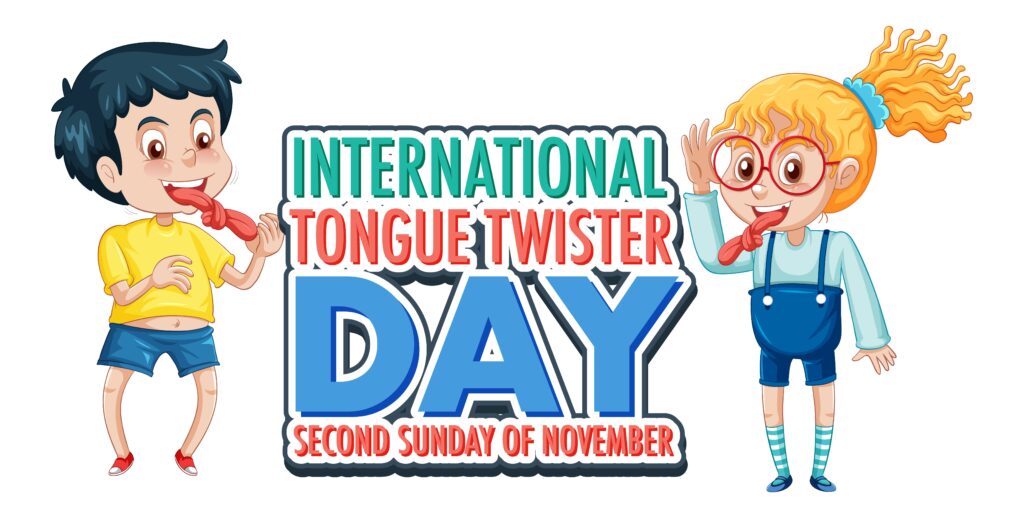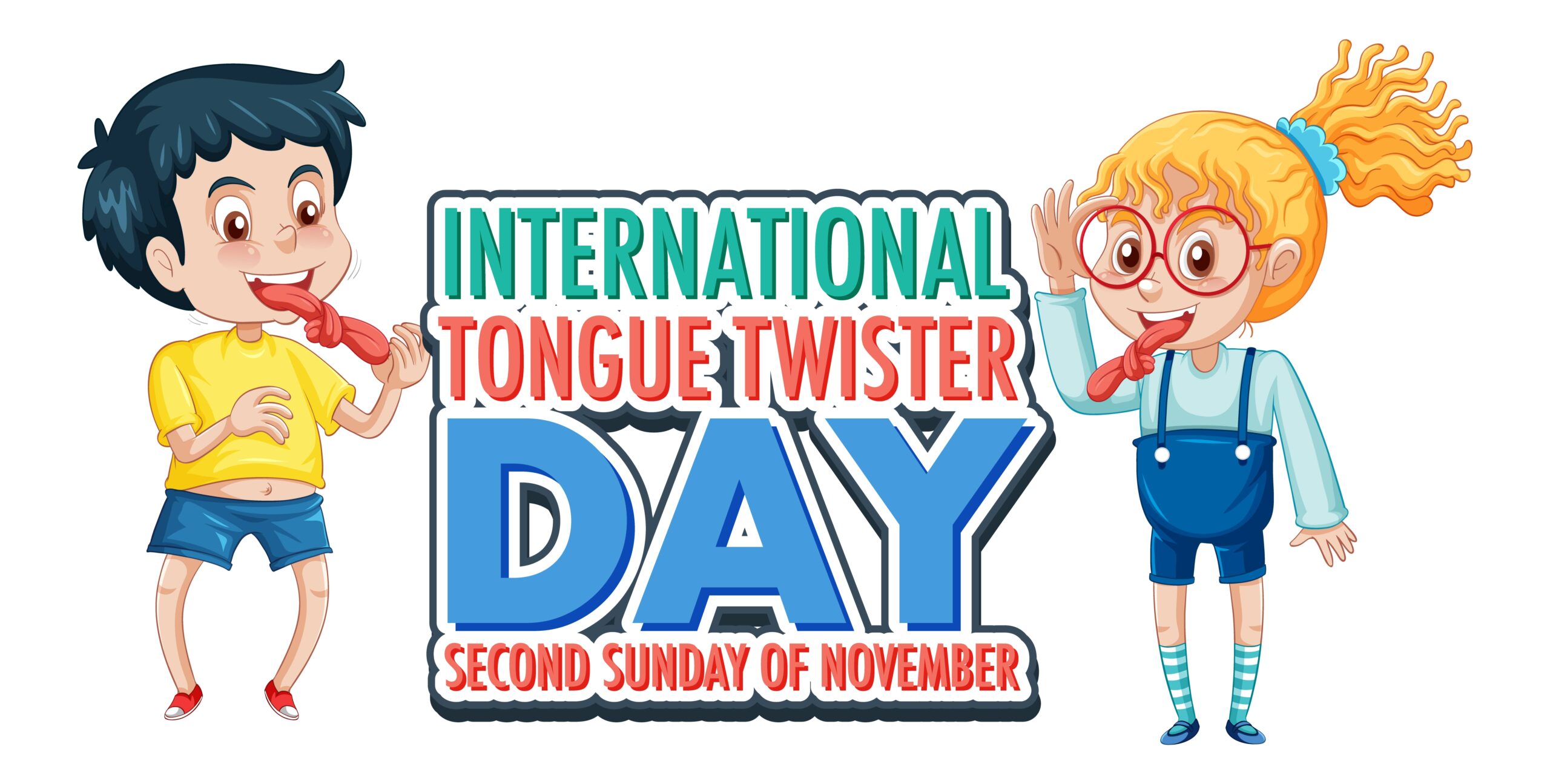Welcome to the whimsical realm of wordsmiths and linguistic acrobats, where phrases twist and twirl like gymnasts in a linguistic circus. Tongue Twister Day, celebrated with gusto by language enthusiasts around the world, is a delightful ode to the art of verbal contortion. In this article, we’ll unravel the history, explore the science, and embark on a journey through the most perplexing tongue twisters. Get ready to exercise those vocal cords and embrace the linguistic rollercoaster that is Tongue Twister Day!
Tongue Twister Day is celebrated every year on the second Sunday in November
Contents
- The Origins of Tongue Twister Day
- The Science Behind Tongue Twisters
- Unveiling the Art of Crafting Tongue Twisters
- Tongue Twister Day: A Global Celebration
- The Role of Tongue Twisters in Language Development
- Celebrating Tongue Twister Day: Tips and Tricks
- The Future of Tongue Twister Day
- FAQs About Tongue Twister Day
- Conclusion: Celebrate the Verbal Tapestry
The Origins of Tongue Twister Day
Intrigued by the origins of this peculiar celebration? Tongue Twister Day finds its roots in the rich tapestry of linguistic playfulness. It emerged as a tribute to words that tie our tongues into knots and leave us grappling with a symphony of syllables. The day encourages people to dive headfirst into the delightful challenge of mastering these linguistic puzzles, fostering a sense of camaraderie among those who appreciate the beauty of spoken language.
How Tongue Twister Day Started
The inception of Tongue Twister Day can be traced back to language enthusiasts seeking a lighthearted way to celebrate the quirks of the spoken word. The day gained traction through social media, with enthusiasts sharing their favorite tongue twisters and challenging others to unravel the linguistic riddles. Today, it has become a global phenomenon, with people of all ages and linguistic backgrounds coming together to revel in the joy of tongue-twisting fun.
The Science Behind Tongue Twisters
The Linguistic Gymnastics of Tongue Twisters
Ever wondered why certain combinations of words tie our tongues in knots? The science behind tongue twisters lies in their ability to exploit the intricate mechanics of speech. These verbal challenges often involve rapid switches between sounds that engage our tongues and lips in a linguistic dance. The brain, in its attempt to keep up, sometimes falters, leading to amusing slips of the tongue.
How Tongue Twisters Affect the Brain

Delving deeper into the science, tongue twisters offer a fascinating glimpse into the complexities of speech processing in the brain. The rapid-fire succession of phonemes requires precise coordination between various linguistic regions. Studies suggest that practicing tongue twisters can enhance speech fluency and improve overall articulation, making Tongue Twister Day not just a playful celebration but also a potential exercise for linguistic agility.
Unveiling the Art of Crafting Tongue Twisters
Behind the Scenes of Tongue-Tying Phrases
Crafting a perfect tongue twister is an art form that requires a keen understanding of phonetics and a dash of creativity. Linguists and wordsmiths meticulously design these linguistic puzzles, weaving a tapestry of alliteration, consonance, and rhythm. The result? Sentences that challenge even the most eloquent speakers.
Elements of a Classic Tongue Twister
What makes a tongue twister truly challenging? The magic lies in the deliberate use of similar-sounding words and a rhythmic structure that trips up the tongue. Alliteration, where words start with the same sound and consonance, and the repetition of consonant sounds, play pivotal roles in creating the perfect linguistic labyrinth. As you celebrate Tongue Twister Day, take a moment to appreciate the craftsmanship behind these linguistic gems.
Tongue Twister Day: A Global Celebration
From Peculiar Pronunciations to International Participation
Tongue Twister Day transcends linguistic boundaries, bringing together people from diverse cultures and backgrounds. It’s a day when language lovers from every corner of the globe unite to revel in the shared joy of navigating the intricate maze of words.
International Tongue Twister Competitions
Did you know that Tongue Twister Day has inspired international competitions where participants showcase their tongue-twisting prowess? These events draw linguists, performers, and enthusiasts alike, creating a vibrant tapestry of linguistic expression. Whether you’re a casual participant or a serious contender, these competitions add an extra layer of excitement to the global celebration of Tongue Twister Day.
The Role of Tongue Twisters in Language Development
Tongue Twisters: More Than Just Verbal Gymnastics
Beyond the sheer amusement they provide, tongue twisters play a significant role in language development, especially in the formative years. Parents, educators, and speech therapists often incorporate these playful phrases into learning activities to enhance phonemic awareness and promote clearer articulation.
Tongue Twisters for Language Learners

Are you learning a new language? Tongue twisters can be valuable tools for language learners, aiding in pronunciation, rhythm, and overall language fluency. As you celebrate Tongue Twister Day, consider incorporating a few foreign-language tongue twisters into your linguistic repertoire. It’s a fun and effective way to embrace the spirit of this global celebration.
Celebrating Tongue Twister Day: Tips and Tricks
Mastering the Art of Verbal Contortion
As you dive into the festivities of Tongue Twister Day, consider these tips and tricks to make the most of this linguistic celebration. Whether you’re a seasoned wordsmith or a novice explorer of tongue twisters, these insights will enhance your experience.
Tip 1: Start Slow and Gradual
Begin with simpler tongue twisters and gradually work your way up to more challenging ones. This gradual progression allows your tongue and brain to adapt to the unique demands of each twist.
Tip 2: Embrace Laughter and Mistakes
Tongue Twister Day is all about fun and amusement. Embrace the inevitable laughter that ensues when words get tangled, and mistakes happen. It’s part of the joyous journey through linguistic acrobatics.
Tip 3: Create Your Own Tongue Twisters
Channel your inner wordsmith and create personalized tongue twisters. Share them with friends and family, adding a touch of creativity to the collective celebration of Tongue Twister Day.
Tip 4: Join Online Challenges and Competitions
Engage with the global community by participating in online challenges and competitions. Social media platforms often host events where you can showcase your tongue-twisting talents and discover new favorites.
The Future of Tongue Twister Day
A Celebration Set to Echo Through Time
As Tongue Twister Day continues to gain popularity, its future promises even more vibrant celebrations and creative linguistic expressions. From virtual events to innovative tongue twister apps, the ways to engage with and enjoy this celebration are bound to evolve.
Virtual Tongue Twister Experiences
Imagine a future where virtual reality and augmented reality technologies bring tongue twisters to life in immersive experiences. Participants could find themselves navigating a whimsical landscape of words, adding a new dimension to the celebration.
Interactive Tongue Twister Apps
In the digital age, interactive apps could become a staple for Tongue Twister Day enthusiasts. Picture an app that not only challenges you with tongue twisters but also provides real-time feedback on your pronunciation and fluency.
FAQs About Tongue Twister Day
Q1: Why is Tongue Twister Day Celebrated?
A: Tongue Twister Day is celebrated to embrace the playful side of language, challenging individuals to tackle intricate verbal puzzles and fostering a sense of community among language enthusiasts.
Q2: How Can I Participate in Tongue Twister Day?
A: Participating in Tongue Twister Day is easy! Share your favorite tongue twisters on social media, challenge friends and family, or even join local or online competitions to showcase your linguistic agility.
Q3: Are There Different Categories in Tongue Twister Competitions?
A: Yes, Tongue Twister competitions often have categories based on age groups or linguistic proficiency, ensuring a fair and enjoyable experience for participants of all levels.
Q4: Can Tongue Twisters Help Improve Speech Skills?
A: Absolutely! Practicing tongue twisters can enhance speech fluency, improve articulation, and contribute to overall language development, making them valuable tools for individuals of all ages.
Q5: What’s the Longest Tongue Twister Ever Created?
A: The longest recorded tongue twister is the “Peter Piper” rhyme, known for its challenging combination of alliteration and rapid-fire repetition.
Q6: Are There Cultural Variations in Tongue Twisters?
A: Yes, different cultures have their own unique tongue twisters, often reflecting linguistic nuances and regional phonetic patterns. Exploring these variations can be a delightful way to celebrate linguistic diversity on Tongue Twister Day.
Conclusion: Celebrate the Verbal Tapestry
A Final Toast to Tongue Twister Day
As we raise our metaphorical glasses to Tongue Twister Day, let’s savor the linguistic tapestry it unfurls before us. From the science behind the twists to the global celebrations, this day encapsulates the sheer joy of language. So, join the festivities, share your favorite tongue twisters, and revel in the delightful challenge of unraveling the mysteries of words on this whimsical occasion.


